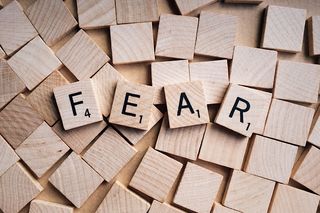
This blog, consists of other people's words this week,
worthy of sharing.
🙏
"Our deepest fear is not that we are inadequate. Our deepest fear is that we are powerful beyond measure. It is our light, not our darkness that most frightens us. We ask ourselves, who am I to be brilliant, gorgeous, talented, fabulous? Actually, who are you not to be?. . .Your playing small does not serve the world. There is nothing enlightened about shrinking so that other people won't feel insecure around you. We are all meant to shine, as children do. We were born to make manifest the glory that is within us. . . It's not just in some of us; it's in everyone. And as we let our own light shine, we give other people permission to do the same. As we are liberated from our own fear,
our presence automatically liberates others." (M. Williamson)
"Fear is a ubiquitous emotion experienced by all beings in varying degrees. All fears originate from our perceptions and past experiences (karmas). Some fears keep us alive and are necessary for our survival. We refer to these fears as instinctual. Other fears keep us from living a fully expressed life, keeping us bound and enslaved. Often an isolating force, these fears widen the gap between our self and others, preventing our divine Self from emerging.
The Taittiriya Upanishads teach that, “until we realize the unity of life, we live in fear.” When we are unsure about the world around us, we typically react in a negative and defensive way, as we interpret the unknown as posing some threat to our comfort or security. Whatever word we use to describe this feeling of insecurity or uncertainty, our reaction is usually rooted in fear. Steeped in our dread, we see the world from a dualistic viewpoint and label things as good or bad or you are this and I am that. Utilizing objects, old ways of thinking and/or our tendencies (gunas) to disengage from the terror we are feeling reinforces the separation of the self from the experience. As a result, we empower the fear that further cocoons our divine Self, distancing us from our innate intelligence, strength, and confidence. If done over a lifespan or the course of many lifetimes this behavior creates mental impressions on the subtle body referred to as samskaras. These impressions deepen through repetitive action, like circling the same path over and over, resulting in a conditioned mundane existence.
As yoga practitioners we have an opportunity to get to the root of our fear and eventually free ourselves of these mental confines and samskaras. Since our body is made up of our karmas, utilizing meditation, asana, pranayama, diet and high intention gives us insight into where we resist the Self. This physical inquiry can resolve our karmas back to their source, opening us up to resolution, healing and subsequent freedom.
With meditation we have the ability to witness our inner landscape, investigating the origins and depths of our fears. As love is the opposite of fear, we notice where we lack in self-love through the observation of our thought patterns and internal dialog. In order to resolve our fears, we must love ourselves enough to face and understand them with a compassionate awareness and a non-judgmental heart.❤
Asana practice helps us further connect to the root of our fears because it allows us to feel the sensation of tension and tightness housed in our bodies. It also affords us the opportunity to observe our fearful reactions to certain postures and the mental and emotional discomfort they elicit. Through asana we are able to explore the edges of what is known and unknown allowing us to uncover resistance in the mind and body. This may be especially apparent with lunges, back bending and other asanas that release the psoas (“so-az”), as this is a key muscle to our fear reflex. Working to release the psoas and stretch the front of the body can provide insight into our emotional state. Important to our postural stability, the psoas links both sides of the lower back to the front body ending at the lessor trochanter, deep inside each hip.
Pranayama practices like nadi shodhana not only clear our energetic channels (ida, pingala, and sushumna), but also stimulate the frontal lobe, the command center to our emotions and personality. It balances both sides of the brain and calms the mind and nervous system. When balanced neurologically, we are less reactive to whatever fears we might be experiencing.
A vegan diet also provides a means to be free of fear. When factory farmed animals are in preparation for slaughter they release stress hormones and other chemicals as a response to the fear of their own death; when we subsequently eat their meat, we consume that fear – one bite at a time. Choosing a diet that doesn’t create fear in other beings will have a direct impact on the fear we experience in our lives.
Incorporating these practices coupled with the high intention of facing what scares us will cultivate familiarity. This familiarity develops the courage needed to change our deeply ingrained responses and relationship to our fears. Once we realize that what we fear is not real but a mental construct, we soften and embrace the totality of life. No longer inhibited and bound by fear we are ignited with a drive to live life courageously. Free and at ease with all that is within us and around us, we are steadily, joyfully and fearlessly connected to the earth" (Giselle Mari)








